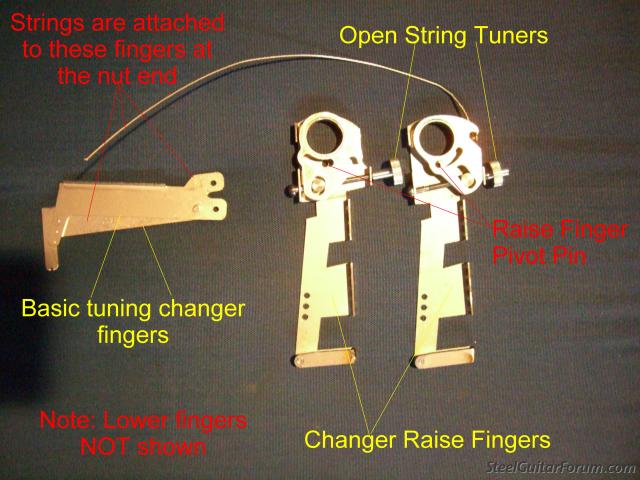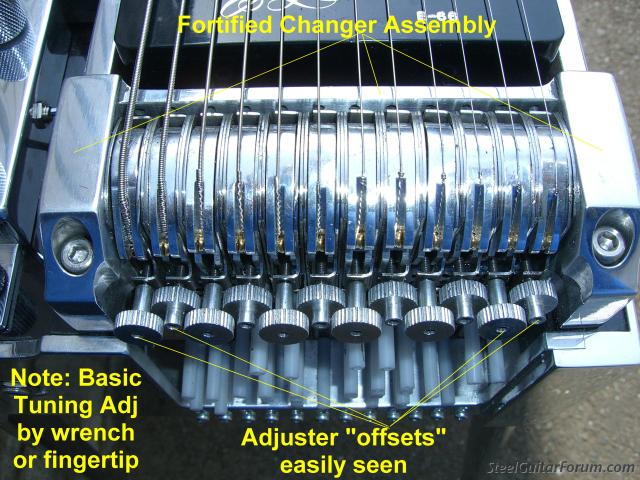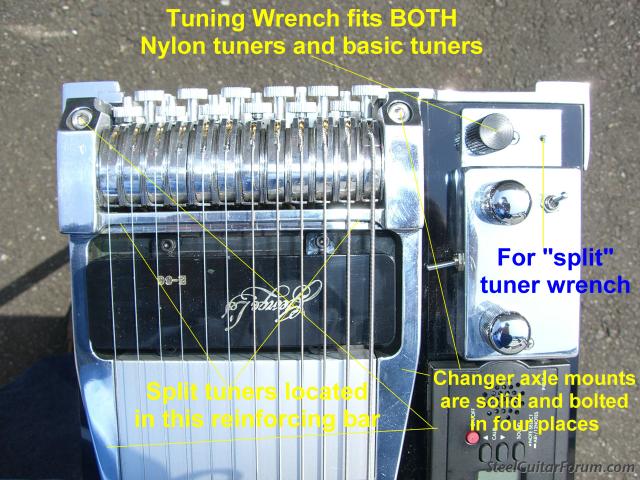| Author |
Topic: New "Optional" Changer on Excel PSG's... |
C Dixon
From:
Duluth, GA USA
|
 Posted 21 Mar 2009 12:37 pm
Posted 21 Mar 2009 12:37 pm |
|
I have received permission from Mitsuo Fujii (Excel Owner) to show new "optional" Excel changer used on the Excel Superb keyless PSG's.
I saw just a couple of prototype raise fingers while in Gulfport recently, where Mitsuo was visiting with Bill Stafford
The main feature of the new changer is that you not only tune the nylon tuners at the right end, BUT you also tune the BASIC tuning at the changer end as well.
Note the following:

1. Every other raise finger has its adjusters offset from one another. This is to allow them to fit side by side. Thus the reason for showing two raise fingers.
2. The raise finger's "adjuster" at the left is all the way "Flat".
3. The right finger's "adjuster" is all the way "Sharp"
It took me a while to see it all, since Mitsuo did not bring the lower fingers with him to Gulfport.
I asked him to send me photos of the raise AND lower fingers. He did and more. Check these out:





In my next post, I will doctor these photos with notes that may answer some questions you might have.
If not, I will try and exlain any questions that I did not address in the doctored photos.
carl
_________________
A broken heart + † = a new heart. |
|
|
|
C Dixon
From:
Duluth, GA USA
|
 Posted 21 Mar 2009 2:48 pm
Posted 21 Mar 2009 2:48 pm |
|
If you have any questions, I will try to answer them.





carl
_________________
A broken heart + † = a new heart. |
|
|
|
Pat Comeau
From:
New Brunswick, Canada
|
|
|
|
richard burton
From:
Britain
|
 Posted 21 Mar 2009 11:18 pm
Posted 21 Mar 2009 11:18 pm |
|
Carl,
Can you show some photos in the lower, open, raise position, as I am having some difficulty understanding the concept. |
|
|
|
Mike Perlowin
From:
Los Angeles CA
|
|
|
|
Tom Quinn
|
 Posted 22 Mar 2009 6:10 am
Posted 22 Mar 2009 6:10 am |
|
Fujii-san is an interesting guy. He has that obsesive drive (a compliment) that many Japanese have to perfect things. I've visited his shop any number of times and attended his winter steel guitar shows as well.
He is a unique individual who, I'm sure, designed this changer to be the best in the world.
Otherwise, he'll re--design it until he gets it right.
Last edited by Tom Quinn on 22 Mar 2009 6:36 am; edited 1 time in total |
|
|
|
ed packard
From:
Show Low AZ
|
 Posted 22 Mar 2009 6:30 am not new
Posted 22 Mar 2009 6:30 am not new |
|
Amazing...now the Excel has both the string retention, AND the integrated tuner/changer that was used on the BEAST! Check it out on the Sierra website.
Not new ideas, but good execution. |
|
|
|
Tom Quinn
|
 Posted 22 Mar 2009 6:37 am
Posted 22 Mar 2009 6:37 am |
|
| 'Course, having said that, it ain't no push-pull... -L- |
|
|
|
C Dixon
From:
Duluth, GA USA
|
 Posted 22 Mar 2009 8:37 am
Posted 22 Mar 2009 8:37 am |
|
| Quote: |
Carl,
Can you show some photos in the lower, open, raise position, as I am having some difficulty understanding the concept. |
Well, I would love to, but that guitar is in Japan, and I am in Atlanta 
I am not sure in what scenario, you are confused, but maybe the following will help:
Firstly; the objective is, the abililty to adjust the "open" tuning AT the right end of the guitar. Thus negating any need to adjust at the keyless end, which is normal on keyless guitars.
Notice the following photo:

In this situation, you would adjust the knurled nuts at the keyless end, to set your open tuning of the steel. Simple enough.
For several reasons, Mitsuo invented a way to eliminate the keyless tuners at the nut end, and incorporate them on the changers instead:
1. It puts the equivalent open tuning AND the nylon tuning at the right end. PLUS the SAME tuning wrench can be used for BOTH the nylon tuners and the open (basic) tuning of the guitar. But for tweaking the open tuning, you can use your finger tips as well.
2. Prior to this newest (optional) changer, Mitsuo introduced a method of changing the entire basic tuning (if desired) with a lever. IE; Tune the basic tuning to E9th. With the flip of a lever, you have C6 or B6 (or whatever you desire) within string gauge limits.
He showed this guitar at last year's ISGC.
This was done at the keyless end. But it was a bit crowded here. So moving the keyless adjusters to the changer end, it allowed the left end to be used for changing the basic tuning to any one of 3 tunings.
But you might also be confused (I and others have been) about HOW this changer works, even without the "open" tuning adjusters.
It is not easily seen at first glance to most. I had to study it for a while to see it work. Since it only uses 2 fingers, HOW can it both raise and lower and NOT have the mechanical restraints of P/P? That is a good question.
The secret lies in the "pivot" points shown in the photos. For those interested, follow along:
For easy reference, I am showing this photo again.

1. The lower finger is typical (more or less) on all PSG's. But the raise finger is NOT, because of HOW it pivots.
2. The lower finger simply pivots on the changer axle rod.
3. But the raise finger pivots ON the lower finger. In order to understand how it operates, you must first visualize this.
4. Thus the reason for a larger hole in the raise finger. Much larger than the diameter of the axle. This allows the raise finger to move from left to right, rather than pivot on the axle. This also is the reason this changer does NOT break strings.
Once you see this mentally, it will make sense in the raising of the string. But HOW does it lower a string?
Well the answer at first may be ellusive. But the secret lies in the fact that AS the lower finger moves to the left, it MOVES the raise finger pivot point to the left; resulting in the raise finger moving to the left also. It took me a while to visualize this. But once seen, it is quite simple.
So the abjective was to have the simplicity of a P/P changer, without having the slop in raises IF that string is also lowered. So this changer is a true All/Pull with ONLY two fingers. This also allows more holes in the changer without the finges being any longer.
This coupled with smaller diameter pull rods, AND internally adjusted nylon tuners, it allows a whopping 7 raise and 5 lower changer.
5. The newest invention is the added "open (basic)" tuning adjuster on the raise finger (knurled knob). In essence this added hardware has NOTHING to do with how the changer works. It simlply changes the open tuning as you adjust the knurled nut. As you screw it clockwise the string goes sharp, and vice versa when you screw it counterclockwise. NO differently than when it was located at the other end of the guitar.
I believe I may have answered the questions and comments so far except for two.
| Quote: |
Fujii-san is an interesting guy. He has that obsesive drive (a compliment) that many Japanese have to perfect things. I've visited his shop any number of times and attended his winter steel guitar shows as well.
He is a unique individual who, I'm sure, designed this changer to be the best in the world.
Otherwise, he'll re--design it until he gets it right. |
I must add an AMEN and AMEN and AMEN.
If it was not for minds like Mitsuo, and a desire to make things better, we would ALL still be swettin' behind a plow and using outhouses. I simply refuse to except the notion that this is a desirable goal.
But to each his own.
| Quote: |
| 'Course, having said that, it ain't no push-pull... |
And thank Jesus! 
Praise His holy name.
carl
_________________
A broken heart + † = a new heart. |
|
|
|
richard burton
From:
Britain
|
 Posted 22 Mar 2009 9:08 am
Posted 22 Mar 2009 9:08 am |
|
Carl,
Thanks for the explanation, I can understand it now, it's similar to the Anapeg system in that the raise is a linear movement.
Having the tuners on the changer end opens up another possibility, namely, that if the strings were locked at the nut (like on regular vibrato-equipped guitars), string hysteresis would be minimised  |
|
|
|
Tom Quinn
|
 Posted 22 Mar 2009 9:46 am
Posted 22 Mar 2009 9:46 am |
|
| Oh Carl, Carl, Carl.... -LLL- I'm still laughing. |
|
|
|
ed packard
From:
Show Low AZ
|
 Posted 22 Mar 2009 10:40 am Don't stop now
Posted 22 Mar 2009 10:40 am Don't stop now |
|
Now that the integrated changer tuner is being offered, add the next steps.
Assuming that the device shown above will allow tightening the G# up to pitch (about ¼” throw required), then;
Change the nut for a string retention plate that uses Fender like string saddles instead of the nut. This allows folk that are annoyed by string top planarity at the nut end to adjust it for gauges, stiffness/angle caused overshoots, and even string length compensation (if desired).
Or…move the integrated tuner/changer to the players left (where it was on the “harps”), and use the string retention plate and Fender like string saddles (with or without the “microtuners”) and with or without the active saddles (piezos). With the piezos, one can have individual string outputs and open up another world of sound. |
|
|
|
Tom Quinn
|
 Posted 22 Mar 2009 11:22 am
Posted 22 Mar 2009 11:22 am |
|
Or practice your right hand technique four hours a day and learn some cut-time Bluegrass songs...
Oops! Gotta go! :- ) |
|
|
|
C Dixon
From:
Duluth, GA USA
|
 Posted 22 Mar 2009 6:34 pm
Posted 22 Mar 2009 6:34 pm |
|
A few comments:
1. I neither approve nor dissaprove this optional changer.
2. It is presented here solely for information.
3. Since, it is in the rawest stages of prototype, nothing above indicates that it will be the final configuration of the finished product.
With that said, I have asked and received photos of the left end of the guitar, which has the optional changer mounted, "open string" tuners shown in previous posts.
I am still studying the pictures to see how it works. But the objective is to allow the player to have up to 4 basic "open" string tunings with the flip of a lever(s).
Notice the following photos that I just received from Mitsuo:



Since I have yet to figure it all out, I will try to describe what I believe to be true as of this writing:
A new type of "changer" is mounted at the nut end of the guitar shown in the first picture above. Also note the following picture:

The two lever (pares) on the left are raise and lower fingers that raise or lower given strings at the nut end. They act as a "changer" at the left end, and are mounted horizontally instead of vertically, as they are in the regular changer at the right end.
Small allen headless screws (24 total-12 flatting and 12 sharping) shown in the 3rd photo above, located in a "shifter bar", are used to change any combination, or all strings, to shift the guitar's open basic (open) tuning when this bar is pulled down by a lever.
You will see in the first photo just one of the bars. In the second photo you will see all three of them. But the player can opt to have 1, 2 or 3 or none of course. I am assuming there will be one lever per bar. And thus up to 3 more "Open" tunings on demand are capable.
The following photos (per my request) of the left underside, I have not figured out yet. I may need to ask Mitsuo what is going on here. I also do not understand the purpose for the 12 phillips head screws in the first photo above. Unless they are used to set the basic tuning and then, the changer mounted tuners at the right end, are used for minor tweaking. But I do NOT know this for sure.


Note: Mitsuo apologized for the guitar being imcomplete and dirty.
carl
_________________
A broken heart + † = a new heart. |
|
|
|
ed packard
From:
Show Low AZ
|
 Posted 24 Mar 2009 2:03 pm Or
Posted 24 Mar 2009 2:03 pm Or |
|
For you UNI players that already have an E9/B6, and might want to play in the C6 pitch, get a Digitech HarmonyMan and pitch shift one halftone on B6 = C6.
You can make your E9 into Eb9 etc.
You won't need another guitar, the one you have will work just fine.
On top of that, it will supply a ton of harmonies.
Google up the DigitTech website and watch a demo. |
|
|
|
Mike Vallandigham
From:
Martinez, CA
|
 Posted 5 May 2009 10:00 am
Posted 5 May 2009 10:00 am |
|
Carl, all I can say is WOWOWOWOW!!
Mitsuo is a true, honest to God genius. I cant wait to see the finished product.
Also, I think the 12 phillips head screws are for helper springs on the headstock end of the guitar, to help sith the changing of the tunings.
Darn good thing I only use e9 and C6, otherwise I'd have to upgrade!!! |
|
|
|
Doug Seymour
From:
Jamestown NY USA (deceased)
|
 Posted 6 May 2009 12:19 pm 12 screws
Posted 6 May 2009 12:19 pm 12 screws |
|
| Seems the 12 raise or lower screws are an adaption of the MultiKord changer head (and maybe also the Fender PS210 changer) to be activated by levers rather than the pedals. Once you change the basic tuning as desired, the pedals and knees could then get the various voicings desired? |
|
|
|
Brad Malone
From:
Pennsylvania, USA
|
 Posted 7 May 2009 6:14 am Thanks Carl and Mitsuo.
Posted 7 May 2009 6:14 am Thanks Carl and Mitsuo. |
|
Mitsuo is a true, honest to God genius. I cant wait to see the finished product<<
A big "thank you" to Carl Dixon. Thanks for all the hard work you did to provide us with the information on the New Excel Steel. It is guys like Mitsuo that give progression, forward movement and advance our cultural. We are so Blessed to be on the planet with guys like him. It sure looks like Mitsuo has taken the Steel to another level. |
|
|
|
ed packard
From:
Show Low AZ
|
 Posted 7 May 2009 6:33 am a tension issue?
Posted 7 May 2009 6:33 am a tension issue? |
|
This appears to be the same system used by VEGA in the 40s. In that case the pedals activated the bars with screws for setting the string tension. I have some reservations when used as Mitsuo appears to be headed. A pedal giving a halftone change without the bar, will need compensation to give a halftone change with the bar...that will be a lot of compensators.
Tension change to change a string a halftone is not the same as that needed to change the string another halftone. What am I missing? |
|
|
|



